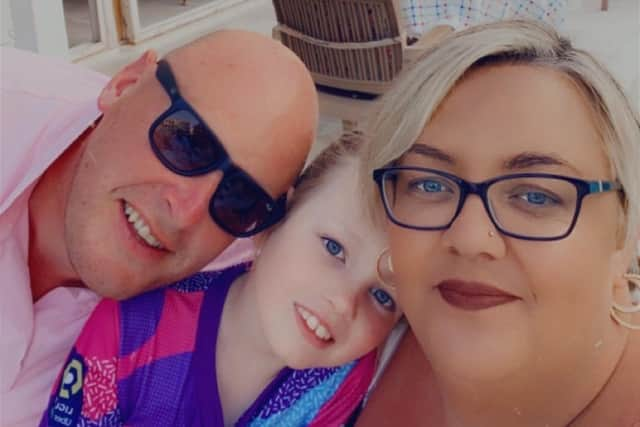Dravet Syndrome: What is it and what it is like to live with
and live on Freeview channel 276
Paige Stocker, from East Sussex, had her first seizure when she was nine months old.
Her mum Gemma said: “It was absolutely horrendous, it last four and a half hours. At the time, it was put down to her having a temperature and being poorly. But she had more seizures after that, each lasting a very long time.”
Paige was diagnosed just before she turned one.
Advertisement
Hide AdAdvertisement
Hide Ad

“Her consultant recognized that it could be Dravet straight away and offered to get her tested,” explained Paige’s dad Martin. “We were lucky in that she could then be put on the right medication, and we could get support in place from the beginning. We’re aware that often families aren’t diagnosed until later on.
“Right away, our consultant Dr Sudarsan at the Royal Alexandra children’s hospital in Brighton, pointed us in the direction of charity DSUK, for support and information. He’s been brilliant with support from Dr Hughes at the Evelina Hospital in London.”
Dravet Syndrome causes epilepsy (severe, treatment-resistant seizures), learning disability and a spectrum of associated conditions, which may include autism, attention-deficit hyperactivity disorder (ADHD), challenging behaviour, and difficulties with speech, mobility, feeding and sleep.
As well as seizures, Paige’s speech and language is also severely affected by Dravet Syndrome.
Advertisement
Hide AdAdvertisement
Hide AdGemma said: “On my birthday recently, Paige said ‘Happy Birthday to you’ – and it was such an amazing thing because before that she had said two or three words together. It was so emotional. It might not sound like a big deal, but for us it was just huge."
Although officially a ‘rare’ condition Dravet Syndrome is one of the most common genetic epilepsies, as well as one of the most treatment resistant. In around 85 per cent of cases, it is caused by a mutation in a gene known as SCN1A.
It's not uncommon for individuals to have multiple seizures day and night, in some cases hundreds. There is also a much higher risk of SUDEP (Sudden Unexpected Death in Epilepsy) compared to other epilepsies.
Because child and adults with Dravet Syndrome have such complex medical needs, often requiring emergency care, lack of awareness can make living with this devastating condition even more challenging for families. For example, some commonly used epilepsy medications, known as sodium channel blockers, can make seizures worse for those with Dravet Syndrome.
Advertisement
Hide AdAdvertisement
Hide AdGemma said: “When we were first told it might be Dravet Syndrome, it was hard to accept. You can’t help but look it up on Google to try and see how things might be for Paige. It’s not easy as you don’t know what the future holds for her, but every case of Dravet is different. We take it day by day.
”Paige is doing really well at the moment and her medication manages her seizures pretty well. We know that she is less affected than many other children we know of with the condition.”
The Stocker family are among those helped by Dravet Syndrome UK. As the only UK charity dedicated to supporting those with Dravet Syndrome, they provide emotional, practical, and financial support for more than 550 families with the condition.
The charity also provides education and information for professionals and funds research into the condition.
Advertisement
Hide AdAdvertisement
Hide AdGemma said: “Our advice to parents of newly diagnosed children would be: connect with others, never give up, don’t let it stop you doing what you want to do in life.
”For example, we loved travelling abroad before we had Paige and we now love travelling with her. It’s not easy, but it’s all in the planning. We check before we go that there is a hospital within reach of where we’re going. We especially love going to Turkey. She has had seizures when we’re there and the hospital has been brilliant.
"Day to day our lives changed completely when Paige was diagnosed. She has to have 24/7 care. But we manage. It helps that we have very supportive families.”
Gemma explains that the family have become experts, learning to read the signs when Paige is going to have a seizure and they work with the charity to pass on their knowledge to other families.
Advertisement
Hide AdAdvertisement
Hide AdShe added: “A good tip we’d pass on to others is to keep a seizure diary to keep a record of how long the seizure lasted and what type it was, so you can see if there’s a pattern. It’s also a good idea to record it if you can, though of course that’s not easy if only one of you is there at the time.
“We do all we can to support DSUK. Martin has fundraised for the charity over the years raising £10k to help their work.”
Galia Wilson, Chair and Trustee, Dravet Syndrome UK, says: “Scientific understanding of Dravet Syndrome has improved significantly during the past decade. The availability of genetic testing has helped increase diagnosis and now there are newer, more effective treatments available too, such as fenfluramine, which has been recently recommended by NICE. But wider awareness is needed to bring attention to these advances if they are to bring real-life benefit to as many patients and their families as possible."
If you suspect that your child has Dravet Syndrome, ask your GP, or epilepsy consultant if you have one, for a genetic test. For more, visit www.dravet.org.uk or email: [email protected]